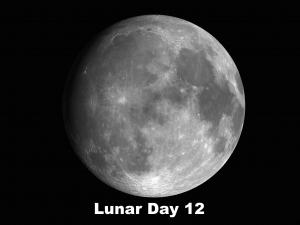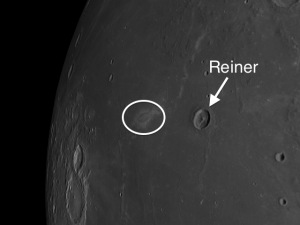The week of April 18-24 takes us from lunar Day 12 through Day 17.
 Full Moon will be on Thursday. This week we will highlight lunar swirls.
Full Moon will be on Thursday. This week we will highlight lunar swirls.
 Reiner Gamma: [NW/J4; L=59°W] (Visible starting Tues.) Lunar swirls are absolutely flat features that cast no shadows but leave enigmatic whorl-like markings on the lunar surface. No known geological process could have created them, and to heighten the mystery, instruments on Apollo spacecraft measured strong magnetic fields directly over the swirls. For the fanciful, they are eerily reminiscent of crop circles. Of the three swirls on the Moon, two have been found to be antipodal features of major impact zones and mascons3. All three of the swirls on the Moon (there are two on the far side) are associated with strong magnetic anomalies.
Reiner Gamma: [NW/J4; L=59°W] (Visible starting Tues.) Lunar swirls are absolutely flat features that cast no shadows but leave enigmatic whorl-like markings on the lunar surface. No known geological process could have created them, and to heighten the mystery, instruments on Apollo spacecraft measured strong magnetic fields directly over the swirls. For the fanciful, they are eerily reminiscent of crop circles. Of the three swirls on the Moon, two have been found to be antipodal features of major impact zones and mascons3. All three of the swirls on the Moon (there are two on the far side) are associated with strong magnetic anomalies.
OF ADDITIONAL INTEREST FROM LUNAR DAY 12 – DAY 17:
Jupiter will be high in the sky all week. Even with small telescopes, you can see its moons and the cloud bands.
On Wednesday, when it’s still twilight, around 8:30 PM, take your binoculars and scan the horizon above where the sun had set and you will see something that the great Copernicus himself never saw: the planet Mercury! It will be about 10° above the horizon (the width of your outstretched closed fist). Take care that you do this after the sun has completely set! Permanent eye damage may result if you accidentally view the Sun through your binoculars! Then take your binoculars down and try to find it without them. (It shouldn’t be difficult. It will be at magnitude +0.6.) The planet will be about half way between the horizon and the Pleiades.
3 Areas of the Moon’s surface that were discovered to have unusually strong local gravitational effects due to concentrations of dense, thick lunar material [formed from mas(s) + con(centration)]
======================
It is highly recommended that you get a copy of Sky and Telescope’s Field Map of the Moon, the very finest Moon map available for use at the telescope. It is available for $10.95 at www.skyandtelescope.com and on Amazon. All features mentioned in this blog will be keyed to the grid on the Field Map and will look like this: Plato: [NW/D9]
Credits:
Courtesy of Gray Photography of Corpus Christi, Texas
Lunar photos: NASA / USGS / BMDO / LROC / ASU / DLR / LOLA / Moon Globe. Used by permission
- Trio of Moon Craters with Distinct Personalities - April 22, 2024
- Hippalus Rilles on the Moon - April 15, 2024
- Moon Crater Janssen: How New Moon Craters are Superimposed on Top of Older Craters - April 8, 2024